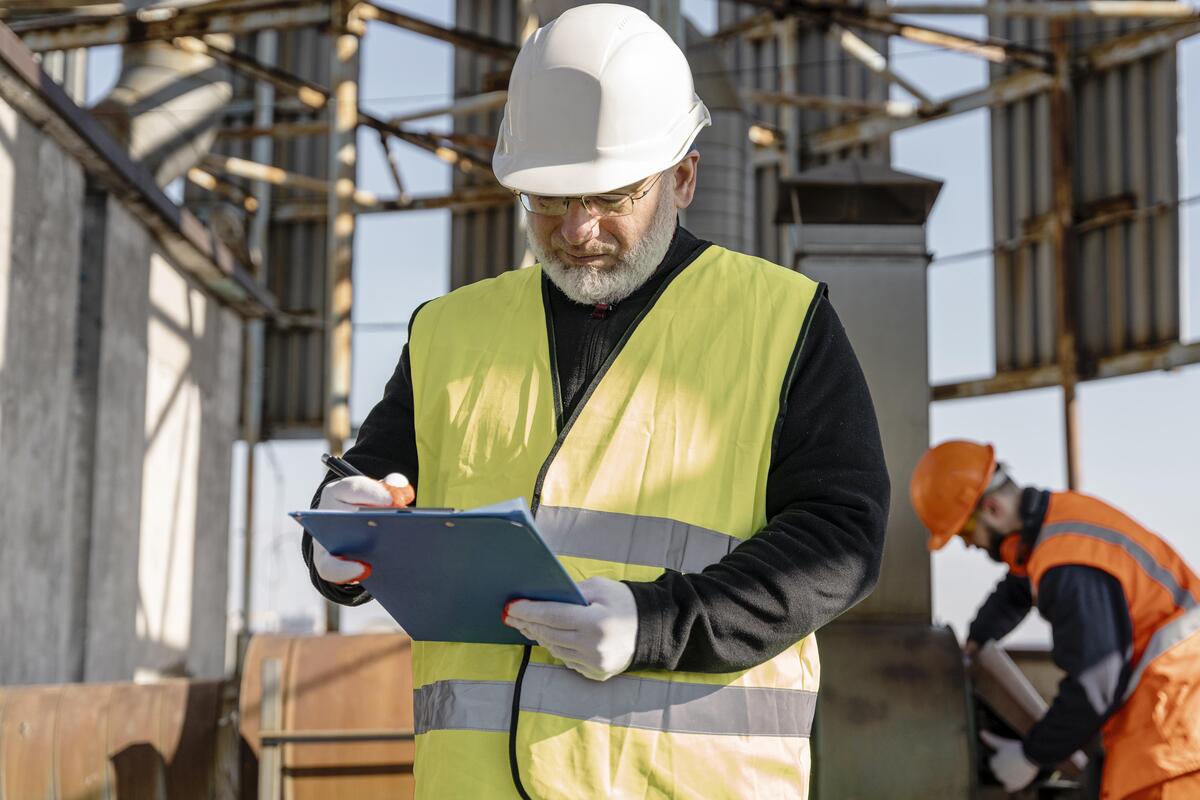The construction industry, traditionally reliant on manual processes and isolated data management systems, is experiencing a technological revolution with the advent of the Internet of Things (IoT). By 2027, the global market for IoT in construction is projected to reach $19.03 billion, growing at a compound annual growth rate (CAGR) of 14.9% from 2020.
This growth is driven by the increasing demand for automation, real-time data collection, and enhanced project management. IoT, a network of interconnected devices equipped with sensors and software, facilitates seamless communication and data exchange over the internet.
In construction, IoT devices are integrated into machinery, materials, and the work environment to gather critical data on performance, safety, and environmental conditions. This real-time data collection and analysis transform traditional practices, leading to significant improvements in efficiency, accuracy, and decision-making. The shift towards IoT in construction data management addresses longstanding challenges in the industry, such as data silos, inaccuracies, and delayed decision-making.
By leveraging IoT technology, construction companies can streamline operations, enhance safety, and reduce costs, setting the stage for a more productive and innovative future. This article explores the transformative impact of IoT on construction data management, highlighting its benefits, challenges, and future potential.
Table of Contents
Background
The Internet of Things (IoT) refers to a network of interconnected devices that communicate and exchange data over the internet. These devices, equipped with sensors, software, and other technologies, collect and transmit data in real-time, enabling automation and enhanced decision-making processes. IoT extends across various industries, including healthcare, manufacturing, agriculture, and, notably, construction.
In the construction industry, IoT has emerged as a transformative force, reshaping traditional practices and introducing new efficiencies. By integrating IoT devices into construction sites and equipment, stakeholders can gather vast amounts of data on various aspects of a project, including machinery performance, worker safety, environmental conditions, and material usage. This data, when analyzed, provides valuable insights that can significantly enhance project management, reduce costs, and improve overall productivity.
Suggested article to read: What is IoT in Construction? Definition, Applications and Steps (2025)
Traditional Data Management Challenges
Before the advent of IoT, data management in construction was often a manual and cumbersome process. Project managers relied heavily on paper-based documentation, spreadsheets, and isolated software systems to track progress, manage resources, and ensure safety compliance. This approach presented several challenges:
- Data Silos: Information was often stored in disparate systems, making it difficult to obtain a comprehensive view of the project.
- Inaccuracies and Errors: Manual data entry and documentation were prone to human error, leading to inaccuracies that could impact project timelines and budgets.
- Delayed Decision-Making: The lag in data collection and reporting delayed critical decision-making, potentially leading to project delays and increased costs.
- Limited Real-Time Monitoring: Without real-time data, it was challenging to monitor ongoing construction activities and respond promptly to any issues or changes.
The Shift Towards IoT in Construction Data Management
The introduction of IoT in construction data management addresses these challenges by providing a more streamlined, accurate, and real-time approach to data collection and analysis. IoT devices, such as sensors, drones, and smart machinery, continuously gather data from the construction site, feeding it into centralized platforms where it can be analyzed and visualized in real-time.
This shift from traditional methods to IoT in construction data management enables construction companies to:
- Integrate Data Sources: Combine data from various IoT devices and systems into a single, cohesive platform, eliminating silos.
- Enhance Accuracy: Reduce human error by automating data collection processes.
- Enable Real-Time Monitoring: Provide stakeholders with up-to-the-minute information on project status, enabling quicker and more informed decision-making.
- Improve Efficiency: Streamline operations and resource management through better data insights.
By overcoming the limitations of traditional data management, IoT is paving the way for a more efficient, safe, and cost-effective construction industry, setting the stage for further advancements and innovations in the years to come.
Suggested article to read: What is IoT Tender? 2025 Guide

The Role of Data Management in Construction
Data management is a critical component of the construction industry, as it encompasses the collection, storage, processing, and analysis of data throughout the lifecycle of a construction project. Effective data management ensures that accurate, timely, and relevant information is available to all stakeholders, facilitating better planning, coordination, and execution of construction activities. The importance of data management in construction can be summarized as follows:
- Project Planning and Design: Accurate data is essential for developing detailed project plans and designs. This includes information on site conditions, materials, labor, and costs. Good data management helps create realistic schedules and budgets, reducing the risk of overruns.
- Resource Allocation: Efficient data management allows for optimal allocation of resources such as labor, materials, and equipment. By analyzing past and current data, project managers can forecast needs and prevent shortages or excesses, thus improving cost control and productivity.
- Risk Management: Comprehensive data collection and analysis help identify potential risks early in the project. By understanding these risks, construction managers can develop mitigation strategies to minimize their impact on project timelines and budgets.
- Quality Control: Data management ensures that construction quality standards are maintained by continuously monitoring various project parameters. This includes tracking material quality, construction methods, and compliance with safety regulations.
- Communication and Collaboration: Effective data management enhances communication and collaboration among project stakeholders, including architects, engineers, contractors, and clients. Shared access to accurate and up-to-date information ensures that everyone is on the same page, reducing misunderstandings and improving coordination.
Suggested article to read: Why Construction Data Management is Crucial for Successful Projects (2025)
Traditional Data Management Challenges
Despite its importance, traditional data management in construction has faced several significant challenges:
- Data Silos: Historically, construction data has been stored in isolated systems or even in paper-based formats. These silos make it difficult to obtain a comprehensive view of the project, as information is fragmented and not easily accessible.
- Inaccuracies and Errors: Manual data entry and documentation are prone to human error, which can lead to inaccuracies that affect decision-making and project outcomes. Errors in data can result in incorrect estimates, scheduling conflicts, and cost overruns.
- Delayed Decision-Making: The time-consuming process of collecting, entering, and analyzing data manually often results in delays. This lag can prevent timely decision-making, leading to missed opportunities to address issues before they escalate.
- Limited Real-Time Monitoring: Traditional data management systems often lack the capability for real-time data collection and monitoring. This limitation makes it challenging to respond promptly to changing conditions on the construction site, such as weather changes, equipment failures, or safety hazards.
Benefits of Improved Data Management
By addressing these challenges, improved data management offers numerous benefits to the construction industry:
- Enhanced Project Visibility: Centralized and integrated data management systems provide a holistic view of the project, enabling better tracking of progress and identification of potential issues.
- Greater Accuracy: Automation and digital tools reduce the risk of human error, ensuring more accurate and reliable data. This accuracy leads to better estimates, scheduling, and resource management.
- Real-Time Insights: Advanced data management systems, particularly those powered by IoT, provide real-time insights into project conditions. This capability allows for immediate action to address problems and optimize operations.
- Informed Decision-Making: Access to accurate and timely data enables construction managers to make informed decisions that enhance project outcomes. This includes adjusting schedules, reallocating resources, and improving safety measures.
- Cost and Time Savings: Improved data management leads to more efficient operations, reducing waste and avoiding delays. This efficiency translates to significant cost and time savings over the course of a project.
Effective data management plays a pivotal role in the construction industry by enhancing planning, resource allocation, risk management, quality control, and stakeholder collaboration. Overcoming the challenges associated with traditional data management methods through the adoption of advanced technologies and practices can lead to substantial improvements in project performance and outcomes.
Suggested article to read: 25 Best IoT Conferences and Events to Attend in 2025

How IoT is Transforming Data Management in Construction
Real-Time Data Collection and Monitoring: One of the most significant ways IoT is transforming data management in construction is through real-time data collection and monitoring. IoT devices, such as sensors, drones, and wearable technology, continuously gather data from various sources across a construction site. This real-time data collection allows for instantaneous monitoring of:
- Equipment Performance: Sensors attached to construction machinery can track usage patterns, operational efficiency, and maintenance needs. This data helps in predictive maintenance, reducing downtime and extending the lifespan of equipment.
- Environmental Conditions: Weather sensors and environmental monitoring devices provide real-time data on temperature, humidity, and air quality. This information is crucial for ensuring safety and scheduling weather-dependent tasks.
- Construction Site Safety: Wearable devices worn by construction workers can monitor vital signs, detect hazardous conditions, and send alerts in case of emergencies. This enhances worker safety and enables swift responses to potential dangers.
By leveraging real-time data, construction managers can make immediate, informed decisions, improving overall project efficiency and safety.
Improved Accuracy and Precision: IoT devices significantly enhance the accuracy and precision of data collected on construction sites. Traditional data collection methods often rely on manual inputs, which are prone to human error. In contrast, IoT-enabled systems automate data collection, minimizing inaccuracies. Key areas of improvement include:
- Material Management: RFID tags and sensors on materials track their location and usage in real time, ensuring precise inventory management and reducing waste.
- Construction Quality Management: IoT devices can monitor the quality of construction processes, such as concrete curing or structural alignment, providing precise measurements that ensure compliance with design specifications and building codes.
This level of accuracy ensures that projects stay on schedule and within budget, with fewer errors and rework required.
Integration and Interoperability: IoT facilitates seamless integration and interoperability between various systems and devices used in construction projects. This integration creates a unified platform where data from different sources can be combined and analyzed. Examples of integration include:
- Building Information Modeling (BIM): IoT devices can feed real-time data into BIM systems, enhancing the accuracy and timeliness of the digital twin of the construction project. This integration allows for better visualization and management of the project lifecycle.
- Project Management Software: IoT data can be integrated with project management tools, providing up-to-date information on project progress, resource utilization, and scheduling. This integration improves project planning and execution.
- Supply Chain Management: IoT enables real-time tracking of materials and equipment throughout the supply chain, ensuring timely deliveries and reducing delays.
By creating an interconnected ecosystem, IoT enhances collaboration and communication among all stakeholders, from architects and engineers to contractors and suppliers.
Suggested article to read: Supply Chain Management in Construction; Comprehensive Guide 2025
IoT is revolutionizing data management in the construction industry by providing real-time data collection, improving accuracy, and enabling seamless integration across systems. These advancements lead to increased efficiency, enhanced safety, cost savings, and better decision-making. While there are challenges to overcome, the transformative potential of IoT in construction data management is undeniable, paving the way for a more efficient, safe, and productive industry.

Conclusion
IoT is revolutionizing data management in the construction industry, addressing traditional challenges and paving the way for significant advancements. The integration of IoT devices enables real-time data collection and monitoring, providing construction managers with instant insights into equipment performance, environmental conditions, and worker safety. This real-time capability ensures immediate, informed decision-making, enhancing overall project efficiency and safety.
Moreover, IoT enhances the accuracy and precision of data by automating data collection processes, reducing human errors, and improving material management and construction quality. This accuracy ensures projects stay on schedule and within budget, minimizing errors and rework. IoT also facilitates seamless integration and interoperability between various systems and devices, creating a unified platform for comprehensive data analysis and better project management.
The benefits of IoT in construction data management are substantial, including increased efficiency, enhanced safety, cost savings, and improved decision-making. By providing real-time insights and precise data, IoT enables construction companies to optimize operations, reduce waste, and enhance collaboration among stakeholders.
Despite the initial costs and challenges related to data security, privacy, and the need for specialized skills, the transformative potential of IoT in construction data management is undeniable. As the industry continues to adopt IoT technologies, it is set to become more efficient, safe, and productive, driving innovation and success in future construction projects.
Suggested article for reading:
Important Construction Technology in 2025
7 Important Building Technology Ideas for 2025
Resources:
intelevision.pro | Forbes | Sciencedirect.com | MDPI | RSM UK | knack.com
For all the pictures: Freepik



